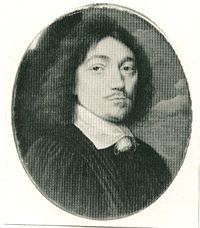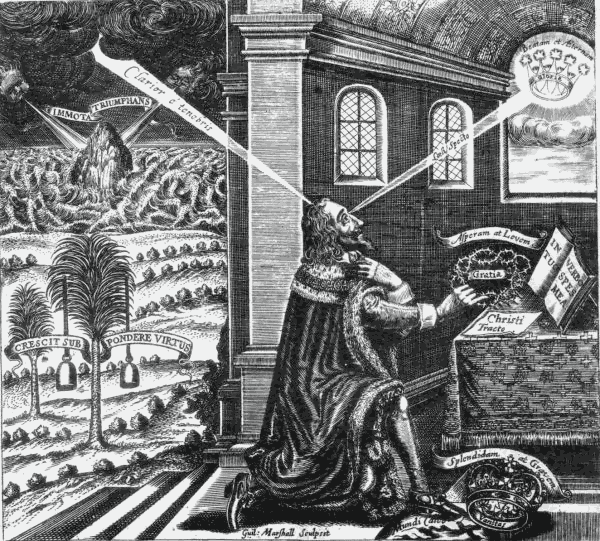
John Gauden
Encyclopedia

Bishop of Exeter
The Bishop of Exeter is the Ordinary of the Church of England Diocese of Exeter in the Province of Canterbury. The incumbent usually signs his name as Exon or incorporates this in his signature....
then bishop of Worcester
Bishop of Worcester
The Bishop of Worcester is the Ordinary of the Church of England Diocese of Worcester in the Province of Canterbury, England. He is the head of the Diocese of Worcester in the Province of Canterbury...
and writer, and the reputed author of the important Royalist work Eikon Basilike
Eikon Basilike
The Eikon Basilike , The Pourtrature of His Sacred Majestie in His Solitudes and Sufferings, was a purported spiritual autobiography attributed to King Charles I of England...
.
Life
He was born at Mayland, Essex, where his father was vicar of the parish, and educated at Bury St Edmunds school and at St John's College, CambridgeSt John's College, Cambridge
St John's College is a constituent college of the University of Cambridge. The college's alumni include nine Nobel Prize winners, six Prime Ministers, three archbishops, at least two princes, and three Saints....
, where he took his M.A. degree in 1626. He married Elizabeth, daughter of Sir William Russell of Chippenham
Chippenham, Cambridgeshire
Chippenham is a village and civil parish in Cambridgeshire, England, part of East Cambridgeshire district around north-east of Newmarket and north-east of Cambridge.-History:The parish of Chippenham covers at the eastern end of Cambridgeshire...
, Cambridgeshire, and was tutor at Oxford to two of his wife's brothers. He seems to have remained at Oxford
Oxford
The city of Oxford is the county town of Oxfordshire, England. The city, made prominent by its medieval university, has a population of just under 165,000, with 153,900 living within the district boundary. It lies about 50 miles north-west of London. The rivers Cherwell and Thames run through...
until 1630, when he became vicar
Vicar
In the broadest sense, a vicar is a representative, deputy or substitute; anyone acting "in the person of" or agent for a superior . In this sense, the title is comparable to lieutenant...
of Chippenham. His sympathies were at first with the parliamentary party. He was chaplain
Chaplain
Traditionally, a chaplain is a minister in a specialized setting such as a priest, pastor, rabbi, or imam or lay representative of a religion attached to a secular institution such as a hospital, prison, military unit, police department, university, or private chapel...
to Robert Rich, 2nd Earl of Warwick
Robert Rich, 2nd Earl of Warwick
Robert Rich, 2nd Earl of Warwick was an English colonial administrator, admiral, and puritan.Rich was the eldest son of Robert Rich, 1st Earl of Warwick and his wife Penelope Devereux, Lady Rich, and succeeded to his father's title in 1619...
, and preached before the House of Commons in 1640.
In 1641 he was appointed to the rural deanery
Deanery
A Deanery is an ecclesiastical entity in both the Roman Catholic Church and the Church of England. A deanery is either the jurisdiction or residence of a Dean.- Catholic usage :...
of Bocking
Bocking
Bocking can refer to:*Bocking, a village near Braintree, Essex*Bocking 14, a cultivated strain of the plant Comfrey*Powerbocking, the use of powered stilts patented by Alexander Böck...
. Apparently his views changed as the revolutionary tendency of the Presbyterian party became more pronounced, for in 1649 he addressed to Lord Fairfax
Thomas Fairfax, 3rd Lord Fairfax of Cameron
Thomas Fairfax, 3rd Lord Fairfax of Cameron was a general and parliamentary commander-in-chief during the English Civil War...
A Religious and Loyal Protestation... against the proceedings of the parliament. Under the Commonwealth
Commonwealth of England
The Commonwealth of England was the republic which ruled first England, and then Ireland and Scotland from 1649 to 1660. Between 1653–1659 it was known as the Commonwealth of England, Scotland and Ireland...
he faced both ways, keeping his ecclesiastical preferment, but publishing from time to time pamphlets on behalf of the Church of England
Church of England
The Church of England is the officially established Christian church in England and the Mother Church of the worldwide Anglican Communion. The church considers itself within the tradition of Western Christianity and dates its formal establishment principally to the mission to England by St...
.
At the Restoration he was made bishop of Exeter
Bishop of Exeter
The Bishop of Exeter is the Ordinary of the Church of England Diocese of Exeter in the Province of Canterbury. The incumbent usually signs his name as Exon or incorporates this in his signature....
. He immediately began to complain to Edward Hyde, 1st Earl of Clarendon
Edward Hyde, 1st Earl of Clarendon
Edward Hyde, 1st Earl of Clarendon was an English historian and statesman, and grandfather of two English monarchs, Mary II and Queen Anne.-Early life:...
, of the poverty of the see, and based claims for a better benefice on a certain secret service, which he explained in January 1661 to be the sole invention of the Eikon Basilike, The Pourtraicture of his sacred Majestie in his Solitudes and Sufferings, put forth within a few hours after the execution of Charles I
Charles I of England
Charles I was King of England, King of Scotland, and King of Ireland from 27 March 1625 until his execution in 1649. Charles engaged in a struggle for power with the Parliament of England, attempting to obtain royal revenue whilst Parliament sought to curb his Royal prerogative which Charles...
as written by the king himself. To which Clarendon replied that he had been before acquainted with the secret and had often wished he had remained ignorant of it. Gauden was advanced in 1662, not as he had wished to the see of Winchester, but to Worcester. He died the same year.
Authorship question

The argument is that Gauden had prepared the book to inspire sympathy with the king by a representation of his pious and forgiving disposition, and so to rouse public opinion against his execution. In 1693 further correspondence between Gauden, Clarendon, the duke of York
Duke of York
The Duke of York is a title of nobility in the British peerage. Since the 15th century, it has, when granted, usually been given to the second son of the British monarch. The title has been created a remarkable eleven times, eight as "Duke of York" and three as the double-barreled "Duke of York and...
, and Sir Edward Nicholas
Edward Nicholas
Sir Edward Nicholas was an English statesman.-Life:He was the eldest son of John Nicholas, a member of an old Wiltshire family.He was educated at Salisbury grammar school, Winchester College and Queen's College, Oxford...
was published by Arthur North, who had found them among the papers of his sister-in-law, a daughter-in-law of Bishop Gauden; but doubt has been thrown on the authenticity of these papers. Gauden stated that he had begun the book in 1647 and was entirely responsible for it. But it is contended that the work was in existence at Naseby
Naseby
Naseby is a small village in the District of Daventry in Northamptonshire, England.The village is 14 mi north of Northampton, 13.3 mi northeast of Daventry, and 7 mi south of Market Harborough. It is 2.4 mi from Junction 2 of the A14 road, giving it access to the national road system...
, and testimony to Charles's authorship is brought forward from various witnesses who had seen Charles himself occupied with it at various times during his imprisonment.
It is stated that the MS. was delivered by one of the king's agents to Edward Symmons, rector of Raine, near Bocking, and that it was in the handwriting of Oudart, Sir Edward Nicholas's secretary. The internal evidence has, as is usual in such cases, been brought forward as a conclusive argument in favor of both contentions.
Doubt was thrown on Charles's authorship in John Milton
John Milton
John Milton was an English poet, polemicist, a scholarly man of letters, and a civil servant for the Commonwealth of England under Oliver Cromwell...
's Eikonoklastes
Eikonoklastes
Eikonoklastes is a book by John Milton, published October 1649. In it he provides a justification for the execution of Charles I, which had taken place on 30 January 1649. The book's title is taken from the Greek, and means "iconoclast" or "breaker of the icon", and refers to Eikon Basilike, a...
(1649), which was followed almost immediately by a royalist answer, The Princely Pelican. Royall Resolves Extracted from his Majestys Divine Meditations, with satisfactory reasons that his Sacred Person was the only Author of them (1649). The history of the whole controversy, which has been several times renewed, was dealt with in Christopher Wordsworth
Christopher Wordsworth
Christopher Wordsworth was an English bishop and man of letters.-Life:Wordsworth was born in London, the youngest son of the Rev. Dr. Christopher Wordsworth, Master of Trinity and a nephew of the poet William Wordsworth...
's tracts in a most exhaustive way. He eloquently advocated Charles's authorship. Since he wrote in 1829, some further evidence has been forthcoming in favor of the Naseby copy.
A correspondence relating to the French translation of the work has also come to light among the papers of Sir Edward Nicholas. None of the letters show any doubt that King Charles was the author. S. R. Gardiner (Hist. of the Great Civil War, iv, 325) regards Charles Doble's articles as finally disposing of Charles's claim to the authorship, but this is by no means the attitude of other writers.
If Gauden was the author, he may have incorporated papers, &c., by Charles, who may have corrected the work and thus been joint-author. This theory would reconcile the conflicting evidence, that of those who saw Charles writing parts and read the MS. before publication, and the deliberate statements of Gauden.

